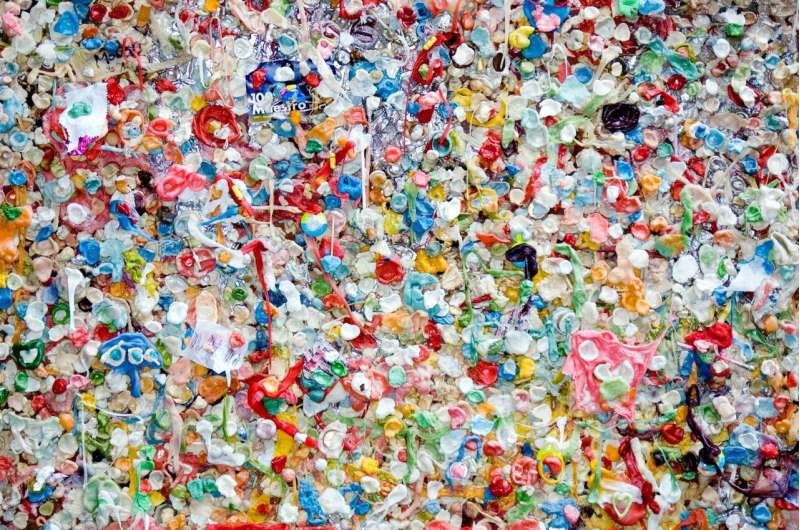Plastics: All around us and inside us

Gaby Clark
scientific editor

Alexander Pol
deputy editor

Plastic is one of the most remarkable materials ever created. It's cheap, lightweight and endlessly versatile. It can be shaped into anything from shopping bags to lifesaving tools in hospitals, and it's clean, safe and can be sterilized. Depending on its purpose, it can be used just once—for example, in medical settings where hygiene is critical—or kept in service for years.
Perhaps surprisingly, plastic can even have environmental benefits thanks to its light weight, which . But we have become so dependent on plastic that global production reached around —a figure that continues to rise every year.
Plastic is part of . Take a toothbrush: the bristles are usually nylon, while the handle is often made from lightweight polyethylene or polypropylene. A manual toothbrush might have a volume of 8.5-19 cm³. Now imagine that over time, it breaks down into microplastics—fragments smaller than five millimeters—or even nanoplastics, which are a thousand times smaller.
If can be as small as 1 micrometer (about the size of a bacterium)—or even 0.1 micrometers (roughly the size of the SARS-CoV-2 virus)—a single toothbrush could theoretically break into 8.5-19 trillion microplastics. And these particles are small enough to be inhaled or ingested.
Plastics don't simply "vanish" in the environment: they fragment. Sunlight, especially ultraviolet-B (UV-B) radiation, ; physical stress—waves, wind, abrasion—breaks it into ever-smaller pieces. Even the state of the stratospheric ozone layer, which controls how much UV-B reaches Earth, . Some bacteria and fungi can also contribute to , but this is .
The result? Most plastic waste ends up as a soup of micro- and nanoplastics drifting through our environment.
While larger plastic debris can cause obvious harm, such as entangling wildlife or being swallowed by seabirds, microplastics are a quieter but potentially more insidious problem.
Plastic everywhere
Microplastics have now been found inside and are present at every level of the food chain. These particles are oil-like (hydrophobic), which helps them cross biological membranes and enter the cells of living organisms—unlike water-loving (hydrophilic) particles such as grains of sand, which follow a different biological path.
Their size matters, too. Smaller particles can travel more easily within the body, reaching organs far from where they first entered. Exposure can occur through swimming in polluted water or via food and drink—either because the food itself contains plastic particles (such as seafood from contaminated waters) or because it's been contaminated during packaging or industrial processing.
Micro- and nanoplastics can also be inhaled in airborne dust, particularly in certain workplaces, such as textile manufacturing or sandblasting with plastic-based materials. In everyday life, we can breathe in synthetic fibers shed from our clothes or tiny particles released from tire wear.
Once inside, microplastics have been found to move—a process called —within animals, a phenomenon that has not been found in humans yet.
that micro- and nanoplastics are present in human liver, kidney, lung, spleen, blood, heart and brain. In , nanoplastic shards of polyethylene were detected in human brains, at higher concentrations than in the liver and kidney. They have been found in the fat plaque in arteria which is . They have also been found in the , suggesting that these particles can be transferred across generations.
Given how common plastics are in food and drink, their presence in the human body isn't surprising—but . Samples are often collected in hospital environments where plastics are everywhere, creating a high risk of contamination.
Are they harmful?
associations between plastic particles and human health conditions including , —a lung disease in which tissue becomes scarred and stiff, making it harder to breathe—as well as .
But the science is still young. Large-scale epidemiological studies, which could take years to complete, to determine whether plastics directly cause these illnesses.
The emerging picture is not reassuring. While scientists are , the precautionary principle suggests we should act now to reduce exposure. That means continuing to track how plastics break down, how they enter our bodies and what they might be doing once inside.
Microplastics are no longer "just" an environmental issue: they're a public health concern. And because plastic production is still rising, the scale of the problem is likely to grow before it shrinks.
Provided by The Conversation
This article is republished from under a Creative Commons license. Read the .![]()


















